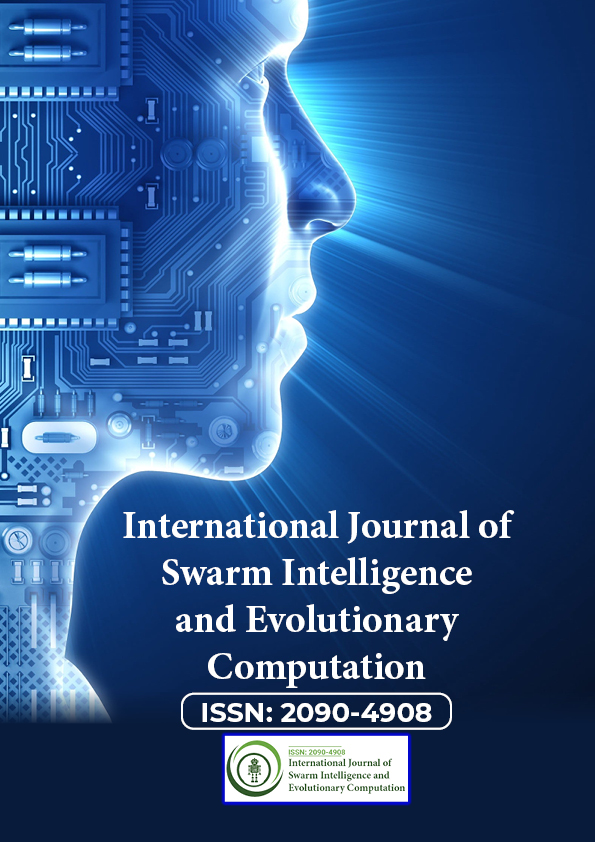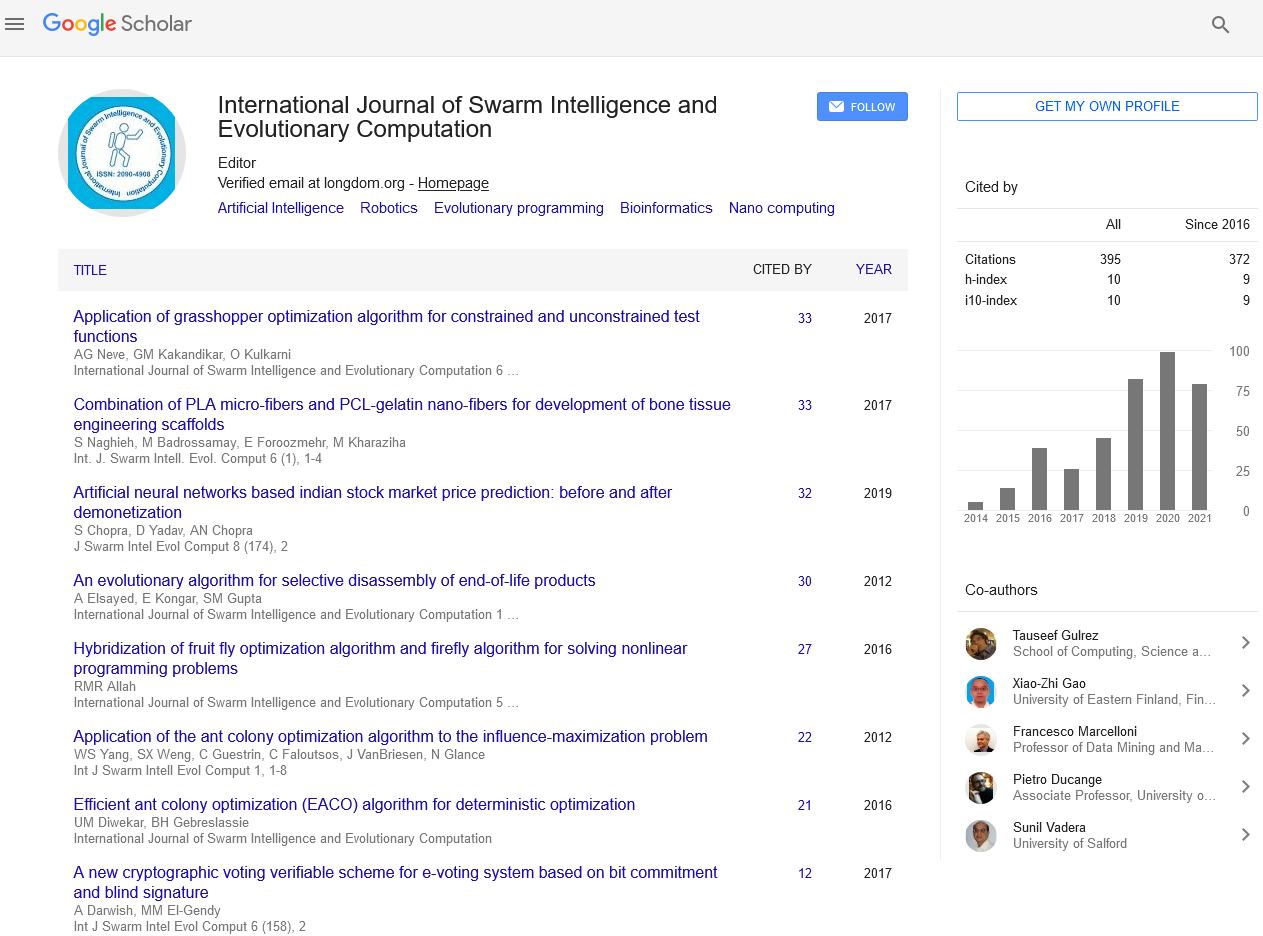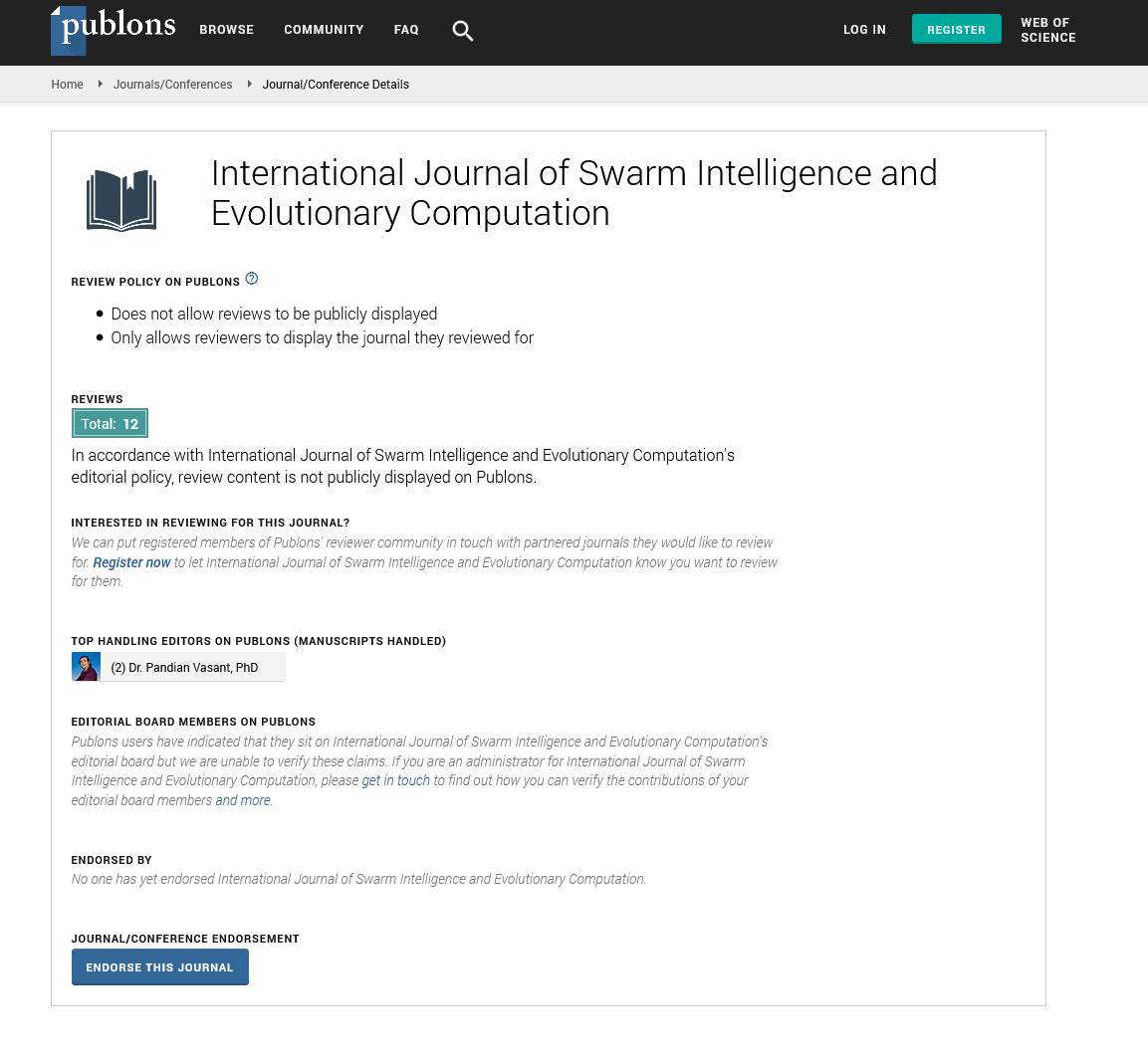Indexed In
- Genamics JournalSeek
- RefSeek
- Hamdard University
- EBSCO A-Z
- OCLC- WorldCat
- Publons
- Euro Pub
- Google Scholar
Useful Links
Share This Page
Journal Flyer

Open Access Journals
- Agri and Aquaculture
- Biochemistry
- Bioinformatics & Systems Biology
- Business & Management
- Chemistry
- Clinical Sciences
- Engineering
- Food & Nutrition
- General Science
- Genetics & Molecular Biology
- Immunology & Microbiology
- Medical Sciences
- Neuroscience & Psychology
- Nursing & Health Care
- Pharmaceutical Sciences
Commentary - (2024) Volume 13, Issue 3
Adaptive Solutions: Exploring the Mechanisms of Evolutionary Programming
Tom Powell*Received: 26-Apr-2024, Manuscript No. SIEC-24-25854; Editor assigned: 29-Apr-2024, Pre QC No. SIEC-24-25854 (PQ); Reviewed: 14-May-2024, QC No. SIEC-24-25854; Revised: 21-May-2024, Manuscript No. SIEC-24-25854 (R); Published: 29-May-2024, DOI: 10.35248/2090-4908.24.13.370
Description
Evolutionary Programming (EP) is a type of evolutionary algorithm that utilizes mechanisms inspired by biological evolution to solve complex optimization problems. Rooted in the principles of natural selection and survival of the fittest, EP iteratively refines a population of candidate solutions to converge towards an optimal or near-optimal solution. Evolutionary programming was first introduced by Lawrence J. Fogel in the 1960s. Unlike other evolutionary algorithms such as genetic algorithms and genetic programming, which emphasize the recombination of genetic material, EP focuses primarily on the evolution of behavioral models and relies on mutation as the primary operator. This distinction allows EP to be particularly effective in continuous optimization problems where the solution space is vast and complex.
Mechanisms of evolutionary programming
Mechanisms of evolutionary programming includes:
Initialization: The process begins with a randomly generated population of candidate solutions, also known as individuals. Each individual is typically represented by a set of real-valued parameters that encode a potential solution to the problem at hand.
Fitness evaluation: Each individual is evaluated using a fitness function, which quantifies the quality or performance of the solution. The fitness function is problem-specific and serves as the criterion for selection and reproduction.
Selection: Individuals are selected based on their fitness scores. Common selection methods include tournament selection and stochastic universal sampling. The goal is to favor betterperforming individuals while maintaining diversity within the population.
Mutation: The selected individuals undergo mutation, a process that introduces small random changes to their parameters. Unlike genetic algorithms, evolutionary programming typically does not use crossover. The mutation process mimics the natural variations that occur in biological organisms and it is important for exploring the solution space.
Competition and replacement: The mutated individuals compete with the existing population for survival. This competition can be implemented using various strategies, such as deterministic crowding or probabilistic selection. The individuals that perform better replace the weaker ones, ensuring that the population evolves over generations.
Termination: The process iterates through multiple generations until a termination criterion is met. This criterion could be a predefined number of generations, a convergence threshold, or a satisfactory fitness level.
Applications of evolutionary programming
Evolutionary programming has been successfully applied in various fields, demonstrating its versatility and effectiveness. Some notable applications include:
Engineering design: EP is used for optimizing design parameters in engineering problems, such as aerodynamic shapes, structural components, and control systems.
Artificial Intelligence (AI): In AI, EP is used to evolve neural networks, optimize machine learning models, and develop autonomous agents.
Financial modeling: EP aids in financial forecasting, portfolio optimization, and risk management by optimizing complex mathematical models.
Bioinformatics: EP is applied to sequence alignment, protein folding, and genetic pathway analysis in the study of biological systems.
Challenges and future directions
Despite its advantages, evolutionary programming faces several challenges. The selection of appropriate mutation rates, maintaining population diversity, and ensuring convergence to global optima are critical issues that require careful consideration. Additionally, the computational cost of evaluating fitness functions for large populations can be significant. Future research in evolutionary programming is likely to focus on hybrid approaches that combine EP with other optimization techniques, such as machine learning and swarm intelligence, to enhance performance and scalability. The development of adaptive algorithms that can dynamically adjust parameters and strategies based on the problem landscape is another potential direction.
Conclusion
Evolutionary programming is a powerful and flexible optimization technique inspired by the principles of natural evolution. Its emphasis on mutation and selection allows it to effectively explore complex solution spaces and find optimal solutions in a wide range of applications. As research in this field continues to advance, EP is poised to play an increasingly important role in solving some of the most challenging problems in science and engineering. Through ongoing innovation and refinement, evolutionary programming will continue to evolve, driving progress in optimization and artificial intelligence.Citation: Powell T (2024) Adaptive Solutions: Exploring the Mechanisms of Evolutionary Programming. Int J Swarm Evol Comput. 13:370.
Copyright: © 2024 Powell T. This is an open-access article distributed under the terms of the Creative Commons Attribution License, which permits unrestricted use, distribution, and reproduction in any medium, provided the original author and source are credited.


